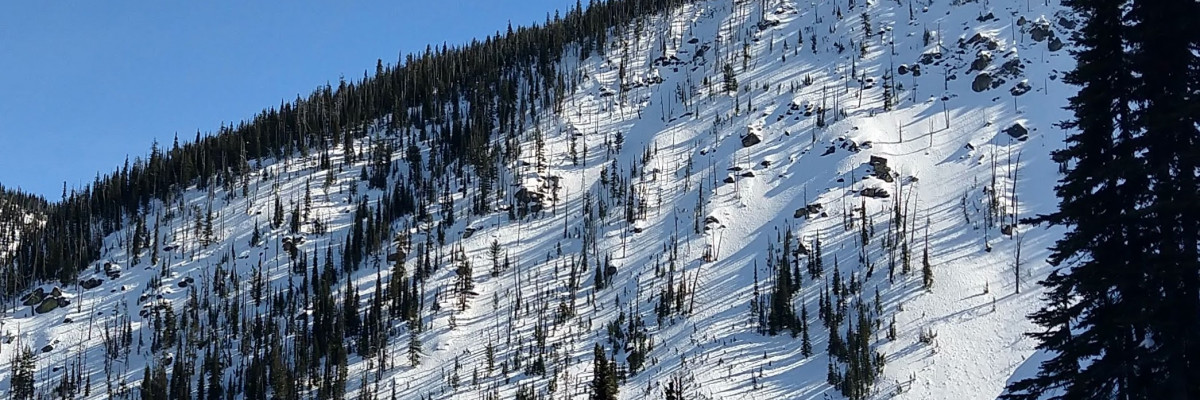The avalanche danger is MODERATE in the west central Montana backcountry.
Good morning, this is Jeff Carty with the West Central Montana avalanche advisory for March 7, 2020. Today’s advisory is sponsored by The Trail Head. This advisory does not apply to operating ski areas, expires at midnight tonight, and is the sole responsibility of the U.S. Forest Service.
Weather and Snowpack
Following the winds Wednesday we’ve had a couple days of warm, relatively calm high pressure. There has been no significant precipitation and minimal wind transport.
Temperatures have reached highs of:
- 42º at Point 6, 7897′
- 56º In the southern Missions at 6330′
- 57º at Lolo Pass at 5240′
- 53º In the central Bitterroot at 6400’
- 47ºin the southern bitterroot at 7940′
Temperatures remained above freezing at upper elevations in the southern and central Bitterroot for the past two nights and throughout the entire forecast region last night. Temperatures will remain above freezing until midday today when the freezing level will begin to descend to about 4000′ tonight. Avalanche hazard will decrease as the snowpack refreezes.
All East, South, and West aspects have been heavily affected by sun. Yesterday, rollerballs were abundant. Loose, wet avalanches were entraining snow as they descended. North aspects above 6500’ were holding some dry snow, however, warm overnight temps may have effected these aspects as well.
The warm temps have led to rapid bonding of the windslab that was a concern on Thursday. Overall this problem has stabilized. However, in isolated areas, it may still be possible to trigger a wind slab.
Cornice fall remains an issue. Cornices are giant and are more likely to fail with the warm temperatures.
Our main problem is wet loose avalanches, the potential size of these is increasing with elevated overnight temperatures. These will remain a threat as long as the snow surface is above freezing. Sustained warm temperatures have loosened bonds within the snowpack and may make layers that have been unreactive more sensitive, increasing the risk of slab avalanches. Wet avalanche problems are hard to predict, standard stability tests are not effective. If the snow is wet, grippy and heavy, you are seeing rollerballs or wet loose avalanches move off avalanche terrain or to more shaded slopes. Practice more caution in areas where there are lingering instabilities.
Isolated instabilities to be aware of include:
- Buried surface hoar. It is present and reactive on sections of Mt. Fuji (video) and maybe lurking on other sheltered north slopes. Dig a pit, perform tests and look for it before committing to steep terrain.
- There are near-surface facets growing around the 02/28 crust. While it is not currently an issue, it may become a problem layer with a load of new snow on it.
- Facets around the 02/23 crust are now 9” deep and are reactive in very isolated areas. They failed and propagated very easily on an east slope in the Rattlesnake yesterday, but were not found on other slopes in the area. We found this layer in the Lolo pass area on a SE slope in the last week, and it may be present in other isolated areas.
- In the southern Bitterroot, depth hoar at the bottom of the snowpack is still an uncertainty. Warm temps such as we are experiencing could reawaken dormant depth hoar layers. Choose a shallow spot to dig. If you find weak sugary snow at the bottom of your pit, choose a different slope where this structure is not present.
Bottom Line
Sustained warm temperatures have created a wet loose avalanche hazard. There is an increasing risk of slab avalanches due to thaw instabilities where mountain temps have remained above freezing overnight. Very isolated pockets of a buried surface hoar and crust/facet layers exist. Depth hoar in the southern Bitterroot is a low likelihood, high consequence problem and still deserves caution. Travel one at a time in avalanche terrain, carry a beacon, shovel, and probe, and stay alert for signs of instability. Look for red flags. Give cornices a wide berth, they will be more likely to fall with the warming.
Education
Your observations are extremely helpful! If you get out, please take a minute to fill out the observation form on our website (missoulaavalanche.org), or shoot us a quick email at [email protected].
We offer a variety of avalanche courses throughout the winter. Go to our course offerings page on our website. Check out the list and get yourself enrolled in one of our many courses this winter!
Ski and ride safe.
























